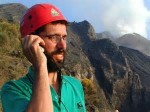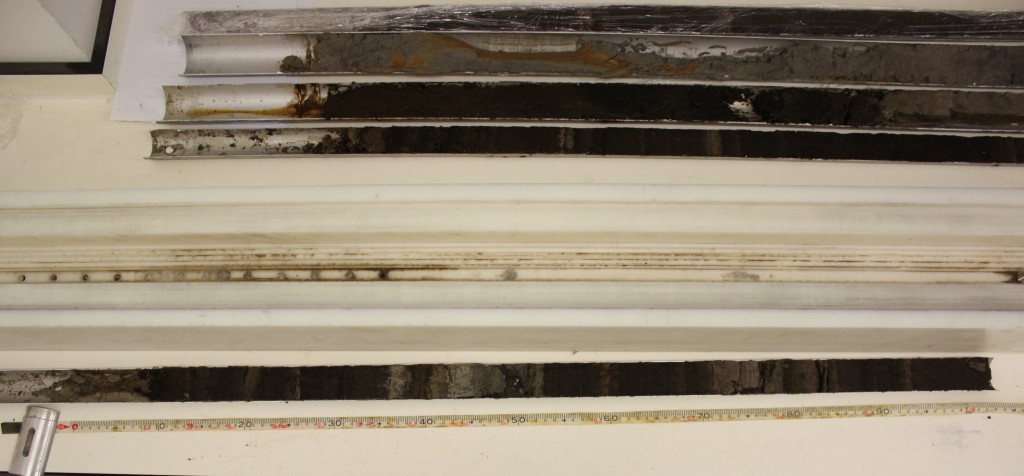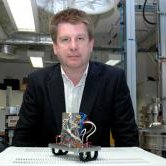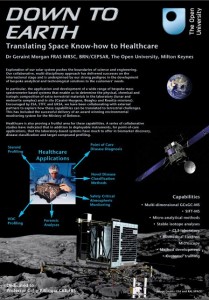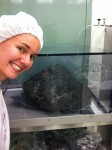Science Matters 2014 Lecture Programme: Perspectives on cutting edge research in physical and environmental sciences
This will take place on 15th December 2014, starting at 1:00pm (13:00 GMT) and finishing by 2.30 (14.30 GMT). The lectures will be held in the Berrill Lecture Theatre at the Open University’s Walton Hall campus.
Places will be allocated on a first come first served basis, so early booking is advised. To book places at this event, please contact cepsar@open.ac.uk by 26 November 2014.
Please note, the talks will be recorded for public viewing so all students should be made aware of this prior to your visit. If you are also bringing students under the age of 16, please complete, sign and return the consent form with your reply form.
Places in the Open University’s lecture theatre are limited. We are therefore providing a live webcast (from 12.55 GMT) to this event for local schools and members of the public. You will find the live webcast through the following link: School-university lectures 2014 Live Webcast
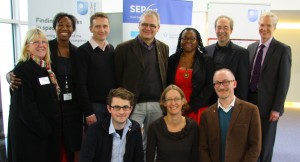
The team who organised and delivered the 2013 Science Matters School Lectures. Back row, l-r: Janet Goss, Diane Ford, Gareth Davies, Andrew Norton, Janice Ansine, Simon Kelley and Tim Blackman. Front row, l-r: Frazer Bird, Clare Warren and Richard Holliman. Photo: Kate Bradshaw.
Event summary
Open University research in the physical and environmental sciences is conducted within CEPSAR.
CEPSAR research focuses on the origins, systems and processes that form the stars and planetary bodies, the processes and natural systems that shape the environment of our habitable world now and in the past, and essential properties of a Solar System that allows life to develop on one of its planets.
In this programme of school lectures, jointly organised with the Denbigh Teaching School Alliance as part of the Engaging Opportunities project, your students will hear from four Open University scientists.
These Open University scientists work at the cutting edge of physical and environmental science research, exploring planetary sciences, ecology and geochemistry. One of them is part of the team that is conducting research on the comet 67P as part of the European Space Agency’s Rosetta Mission.
The talks will be followed by an opportunity to ask questions as the four speakers returned to the stage for a panel Question and Answer session.
Mercury: new views of the Sun’s innermost planet
David Rothery, Professor of Planetary Geosciences, The Open University
In this talk I’ll be discussing what scientists know about the planet Mercury. Thanks to NASA’s MESSENGER (orbiting Mercury since March 2011) we now know far more about the closest planet to the Sun than was possible from ground-based astronomy and the Mariner-10 flybys in the 1970s.
Mercury is a rocky planet with a disproportionately large iron core. The outer core is molten, and dynamo processes there generate a magnetic field (unique among the terrestrial planets apart from Earth).
The planet is surrounded by a thin but variable ‘exosphere’ of atoms released from the surface. The surface is perplexingly rich in elements such as sulfur, potassium, sodium and chlorine that are easily lost to space and there is widespread evidence of explosive volcanic eruptions (mostly more than 3 billion years ago, but extending into the past billion years) that must be driven by expanding gas.

(a) 70 km-wide MESSENGER colour image of Sander crater. The box locates (b).
(b) Detailed view of hollows on the floor of Sander.
Such abundance of ‘volatile’ elements (that easily become gases) is hard to reconcile with models for Mercury’s origin that call for much of its original rocky component to have been stripped away, possibly in a giant impact.
Thermal contraction of the planet as it cooled has led to widespread development of ‘lobate scarps’ at the surface that have absorbed at least 7 km of global contraction. The most recent process to sculpt the surface (other than ongoing impact cratering) is the formation of ‘hollows’ – occurring as fields of steep-sided, flat-bottomed depressions tens of metres deep where a surface layer has been removed, seemingly by some sort of sublimation process, with solid turning directly to vapour. The substance involved has not been identified.
Back to the future II: mad for mud!
Dr Encarni Montoya, NERC Postdoctoral Research Fellow, The Open University
We are aware that planet Earth is different from the poles to the equator, and that we suffer climatic variations from year to year.
Thanks to science we also know that a given location has not been always the same. Both the vegetation and climate have changed through time. We have been able to understand these changes thanks to the study of the past, which also can provide insights about our future world.
How then do scientists measure and analyse environments that do not exist anymore or have not occurred yet? In effect, scientists act as detectives to investigate these scenarios, piecing together the puzzle of environments that have been and could be.
In this sequel to the 2013 talk by Frazer Bird, Encarni will explain how researchers study the past. She will describe a journey that takes palaeoecologists (scientists studying the ecology of the past) from the collection of samples during field work to the publication of the results.
Encarni will focus her talk on how researchers obtain and interpret the results from the data they have collected.
Down to Earth: Translating space know-how to challenges nearer to home
Dr Geraint (Taff) Morgan, Project Officer, The Open University
After 10 years and a 4 billion mile journey around our solar system, Rosetta finally made it to comet 67P in August 2014.
In November 2014 we succeeded in the first ever soft landing on a comet and analyse what it is made from. This was a truly remarkable achievement of science and engineering, generating widespread interest through media channels across the world.
What have we scientists been doing between 2001, when we delivered the Ptolemy instrument to the Philae lander, and November 2014 when we landed on Comet 67P?
The answer is bringing science and engineering back down to Earth…
Exploration of our solar system pushes the boundaries of science and engineering. It is our application and development of a wide range of mass spectrometer-based systems that enable us to determine what extra-terrestrial materials are made from, both in the laboratory and in space.
Encouraged by the European Space Agency we have been collaborating with external partners to explore how these capabilities can be translated to challenges here on Earth. This has included the successful delivery of an award winning safety systems for the Ministry of Defence and a series of healthcare applications. Come and hear how it is we can copy a dog, using scientific instruments to sniff cancer.
Moon river: is our nearest neighbour really dry?
Jessica Barnes, Post-Doctoral Research Associate, The Open University
For almost 25 years lunatics (people who study the Moon!) thought that our nearest neighbour was completely devoid of water.
It is only in the last six years that we have re-examined the Apollo sample and lunar meteorite collections, and found that this longstanding paradigm may need revising.
In this talk Jess will outline the latest discoveries of volatiles in lunar rocks and what these findings tell us about water inside the Moon, and where in our Solar System that water may have originated.
Jessica’s research interests lie in igneous petrology and geochemistry, in particular isotope geochmistry applied to Apollo lunar samples. She is in the process of completing her PhD at the Open University.

